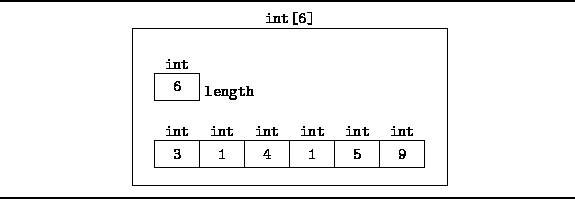|
Data Structures and Algorithms
with Object-Oriented Design Patterns in C# |
Probably the most common way to aggregate data is to use an array. In C# an array is an object that contains a collection of objects, all of the same type. For example,
int[] a = new int[5];allocates an array of five integers and assigns it to the variable a.
The elements of an array are accessed using integer-valued indices. In C# the first element of an array always has index zero. Thus, the five elements of array a are a[0], a[1], ..., a[4]. All array objects in C# have an int property called Length, the value of which is equal to the number of array elements. In this case, a.Length has the value 5.
C# checks at run-time that the index used in every array access is valid.
Valid indices fall between zero and ![]() .
If an invalid index expression is used,
an IndexOutOfRangeException exception is thrown.
.
If an invalid index expression is used,
an IndexOutOfRangeException exception is thrown.
It is important to understand that in C#, the variable a refers to an array object of type int[]. In particular, the sequence of statements
int[] b; b = a;causes the variable b to refer to the same array object as variable a.
Once allocated, the size of a C# array object is fixed. That is, it is not possible to increase or decrease the size of a given array. Of course, it is always possible to allocate a new array of the desired size, but it is up to the programmer to copy the values from the old array to the new one.
How are C# arrays represented in the memory of the computer?
The specification of the C# language leaves this up
to the system implementers[22].
However, Figure ![]() illustrates a typical implementation scenario.
illustrates a typical implementation scenario.

Figure: Memory representation of C# arrays.
The elements of an array typically occupy consecutive memory locations.
That way, given i it is possible to find
the position of ![]() in constant time.
In addition to the array elements,
the array object has a Length property,
the value of which is represented by an int field called length.
in constant time.
In addition to the array elements,
the array object has a Length property,
the value of which is represented by an int field called length.
On the basis of Figure ![]() ,
we can now estimate the total storage required
to represent an array.
Let S(n) be the total storage (memory) needed to
represent an array of n ints.
S(n) is given by
,
we can now estimate the total storage required
to represent an array.
Let S(n) be the total storage (memory) needed to
represent an array of n ints.
S(n) is given by
![]()
where the function ![]() is the number of bytes
used for the memory representation
of an instance of an object of type X.
is the number of bytes
used for the memory representation
of an instance of an object of type X.
In C#, the sizes of the simple data types are fixed constants.
Hence, ![]() .
In practice, an array object may contain additional fields.
For example, it is reasonable to expect that there is a field
which records the position in memory of the first array element.
In any event, the overhead associated with a fixed number of fields is O(1).
Therefore, S(n)=O(n).
.
In practice, an array object may contain additional fields.
For example, it is reasonable to expect that there is a field
which records the position in memory of the first array element.
In any event, the overhead associated with a fixed number of fields is O(1).
Therefore, S(n)=O(n).